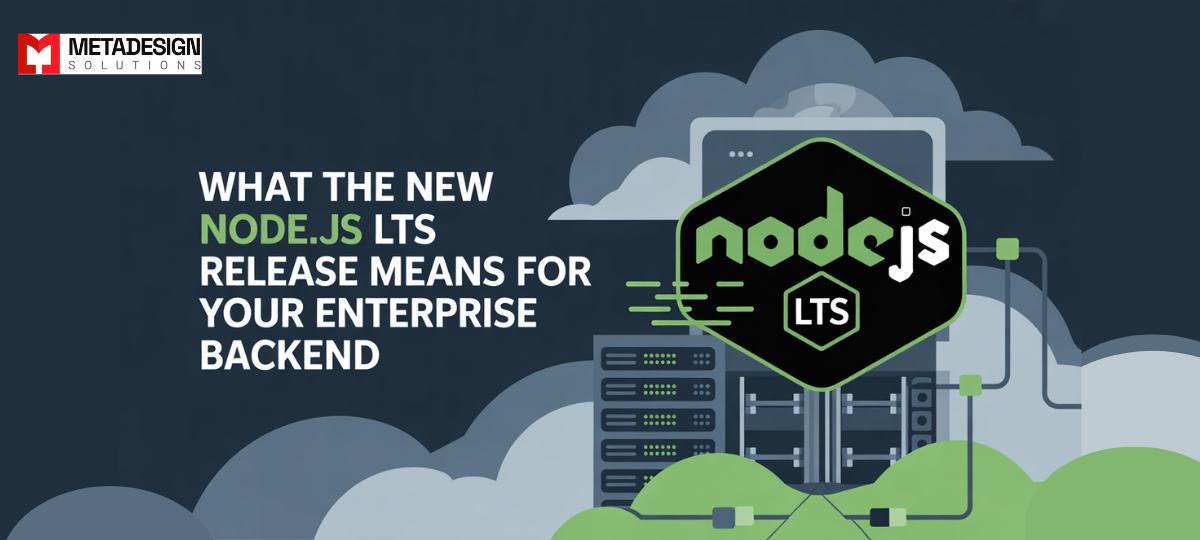I. Introduction: The Criticality of Node.js LTS
Enterprise stability isn’t a luxury; it’s a mandate. When you manage mission-critical production environments—from global e-commerce platforms to internal financial services—you cannot afford volatility or unexpected security gaps.
Unlike experimental, or “Current,” versions of Node.js, the Long-Term Support (LTS) release marks the moment a version is formally deemed stable, predictable, and production-ready.
The LTS cycle guarantees 18 months of active support and an additional 12 months of maintenance for critical bug fixes and security patches. For large-scale backends, this commitment to stability is non-negotiable. Running outside this window is a direct path to accumulated technical debt and mounting security liabilities.
The core question for engineering leaders isn’t if you should migrate, but what specific, measurable improvements in this new LTS version directly impact your bottom line—in terms of performance, security, and developer efficiency.
Thesis Statement: The latest Node.js LTS release delivers measurable gains in speed and memory efficiency while introducing stable, high-value features, making migration a strategic imperative, not just a maintenance task.
II. Pillar 1: Performance Gains and Cost Reduction
When dealing with large-scale traffic, performance gains aren’t just faster page loads; they translate directly into cost reduction and improved resource utilization.
V8 Engine Update Benefits
The heart of Node.js is the V8 engine, the same high-performance JavaScript engine that powers Google Chrome. Every new LTS release incorporates significant updates to V8, and this version is no exception.
- Just-In-Time (JIT) Compiler Improvements: The newer V8 version includes optimizations to its JIT compiler, which translates JavaScript code into machine code more efficiently. This leads to demonstrable improvements in runtime execution speed for typical business logic, API routing, and data processing tasks. Your code simply runs faster without modification.
- Memory Management and Garbage Collection (GC) Refinements: One of the historic performance “hiccups” in Node.js development services has been the brief pauses required for Garbage Collection. The new LTS incorporates specific GC tweaks that result in lower memory usage overall. Crucially, these refinements mean the engine spends less time pausing the application to clean up memory, leading to smoother, more consistent performance under heavy load.
Impact on FaaS and Serverless
For backends leveraging consumption-based cloud services (like AWS Lambda, Azure Functions, or Google Cloud Functions), these performance gains translate directly into cost savings.
- Lower Cold Starts: Improved startup performance leads to faster function initialization. Since FaaS functions are billed from the moment they start, minimizing that initial cold-start latency is key to keeping costs down and maintaining responsive user experiences.
- Cloud Billing Savings: FaaS providers bill based on execution duration and allocated memory. The reduced memory footprint and shorter execution time achieved by the optimized V8 engine lead to direct savings on your cloud bill—scaling performance improvement into enterprise-level budget control.
III. Pillar 2: Architectural and Development Simplification
The new LTS release stabilizes several long-awaited features that standardize development practices, simplify architecture, and lower the cognitive load on your engineering team.
Stabilization of Key Modern Features
- ECMAScript Module (ESM) Stability: The new release offers final, stable support for the import/export syntax that modern frontend developers use. This stability allows Node.js backends to finally align with modern JavaScript conventions, simplifying isomorphic code creation (using the same code on both client and server) and streamlining dependency management.
- Standardized Fetch API (Now Built-in): The global, standardized fetch() API is now native to Node.js. This simplifies external network calls, removing the need to rely on and manage heavy, third-party libraries (like node-fetch). Adopting this standardized approach improves code consistency and reduces the application’s overall dependency surface.
Security and Maintenance Enhancements
- Updated OpenSSL and Core Dependencies: Enterprise security cannot rely on patches alone. The new LTS release bundles the latest, critical security updates to OpenSSL and other core dependencies. Migrating ensures your entire runtime environment benefits from the latest compliance and security best practices out-of-the-box.
Improved Diagnostics and Debugging: The release includes new native tooling, flags, and APIs designed to make the process of tracing production issues far easier. Engineers can now more quickly track down subtle performance bottlenecks, resource leaks, and execution errors, making both debugging and production monitoring cheaper and faster.
Embrace Stability and Performance with the New Node.js LTS Release
Upgrade to the latest Node.js LTS version to ensure your enterprise backend is secure, efficient, and future-ready. Leverage enhanced features and long-term support for sustained business success.
IV. Strategic Migration and Adoption Path
The question is no longer why to upgrade, but how to do so strategically to maintain business continuity.
A. When to Migrate?
- Risk Analysis: If you are running on an older LTS version (e.g., Node 16) that is approaching its End-of-Life (EOL), migration is a security imperative. EOL means no more security patches, making your entire application a liability.
- Feature Adoption: If your current roadmap includes adopting ESM or leveraging the built-in Fetch API, prioritizing migration now allows you to build new features on a modern, future-proof foundation.
B. Planning a Low-Risk Migration
Migrating large, complex enterprise backends requires meticulous planning:
- Testing Strategy: The primary risk in any runtime upgrade is ensuring ecosystem compatibility. You must emphasize comprehensive End-to-End (E2E) and integration testing to catch issues that may arise from subtle changes in the V8 engine’s behavior.
- Dependency Auditing: Create a full manifest of all core NPM packages. You must verify that your most critical dependencies and frameworks (like Express, NestJS, or logging libraries) formally support the new Node.js version before deployment.
C. Leveraging the LTS Window
The 18-month active LTS period is your most stable development window. By migrating early, your development teams can focus on building new, revenue-generating features for a year and a half, knowing the core runtime is stable, secure, and actively supported by the community.
V. Conclusion: Making the Strategic Upgrade
The new Node.js LTS release offers a clear path to lower operational costs, improved developer velocity, and enhanced security compliance. It is the definitive roadmap for high performance and low risk in the modern backend landscape.
Staying on an outdated runtime is not stability; it is accumulating technical debt that will eventually result in a massive, costly overhaul. The new LTS release is your opportunity to invest in a codebase that operates with maximum efficiency.
Ready to implement the new Node.js LTS with zero downtime? Our certified full-stack development services team specializes in low-risk enterprise migrations. We can provide a comprehensive migration readiness assessment to transition your backend seamlessly. Contact us to start your strategic upgrade today.
Relevant Hashtags:
#NodeJS #EnterpriseBackend #LTSRelease #WebDevelopment #BackendDevelopment #TechInnovation #SoftwareEngineering #JavaScript #NodeJSDevelopment #EnterpriseSolutions



